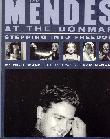SEARCH CurtainUp
REVIEWS
FEATURES
NEWS
Etcetera and
Short Term Listings
LISTINGS
Broadway
Off-Broadway
BOOKS and CDs
OTHER PLACES
Berkshires
London
LA/San Diego
Philadelphia
Elsewhere
QUOTES
On TKTS
LETTERS TO EDITOR
FILM
LINKS
MISCELLANEOUS
Free Updates
Masthead
NYC Weather
 Review
Review
A Streetcar Named Desire
by Dolores W. Gregory
In A Streetcar Named Desire, the opening production of the summer-long Tennessee Williams Explored festival at the Kennedy Center, director Garry Hynes is apparently out to redefine that 1950s icon of brutish sexuality, Stanley Kowalski. Under Hynes' direction, the sexy beast we associate with rippling pectorals under a tight, sweaty white T-shirt has somehow transmogrified into a rather cute '90s guy with an unfortunate, retro tendency to knock his poor wife around.
When his lines don't demand toughness, crudeness, or insensitivity, actor Adam Rothenberg imbues Stanley with a kind of country-boy openness---even though he sports a thick, big-city accent. With his high-pitched voice, shock of thick dark hair, slender build, and all-around boyishness, Rothenberg comes off like a freshman member of the fraternity who has been hanging around with the wrong crowd. Surely he isn't all that bad, and if only the boy would work on his table manners a bit, well, maybe Stan could fit in all right out at the old plantation.
It's not Rothenberg's fault he's no Marlon Brando. Who is? Even Brando isn't Brando any more---but that's the image burned into our brains by the film version that is readily available on video. It's a tall order to ask any actor to knock that image aside. Does the actor exist today who can do it? I don't know, but Rothenberg certainly is not the man for the job----and it isn't his fault. Rothenberg is an otherwise fine actor, but he is simply all wrong for this part.
Perhaps it is Rothenberg's shortcomings in the role that account for co-star Patricia Clarkson's intense performance as Blanche DuBois, the fading belle with the overflowing steamer trunk and the grating snobbery that drive brother-in-law Stanley to violence. Clarkson owns the evening---not just because, as written, Blanche dominates the play, but because the actress inhabits the character so effectively. The ex-schoolteacher's irony and intelligence shine through in Clarkson's layered performance, and her sexual need is played deliciously in a brief scene with a newspaper boy who delivers a chaste kiss at her request. But despite these merits, there's something vital missing in Clarkson's Blanche. The essential, underlying vulnerability of the character is only a faint undertone to Blanche's conniving efforts to land her white knight.
As the story goes, Blanche arrives at Stanley's front door in the French Quarter of New Orleans to seek refuge with her sister Stella. In the course of a steamy summer, she grates on Stanley and endears herself to his poker buddy, Mitch, a man she observes is "superior to the others." Stanley resolves to stop the romance----and sets about uncovering the real reason that Blanche fled her home town for his two-room apartment near the railroad tracks.
Designer John Lee Beatty creates the Kowalski's cramped, two-room flat in lush detail, but Hynes breaks with tradition by locating all the action within those two rooms, or just beyond them, visible through two long windows that overlook the street. The upstairs apartment---where Stella flees to escape Stanley's wrath---is never seen. Instead of going into the street to call for her, he yells through the ceiling. And while the effect is claustrophobic, it is so to the detriment of the play. This is a neighborhood where the heat, the poverty, and the lack of air conditioning assure that, with windows wide open, everyone knows everyone else's business all the time. Yet, we see none of this; instead, the set suggests a place of refuge---crowded, but private, and modestly comfortable.
Against this backdrop the battle of wills unfolds, but it's not an even match. Blanche loses because the script says she does, but really, Clarkson is so powerful in the part, that it is Stanley who ought to go stark-raving mad by the end.
One thing such a casting mismatch achieves, though, is an opportunity to reconsider the text. This production exposes a question that Williams leaves unanswered. Why does Stanley, with his explosive, violent temper, tolerate Blanche at all? Why does he allow her to live off him for months on end while she snootily repays his generosity with constant reminders that he is vulgar and common---simply not good enough for her sister and far inferior to herself? Unlike Blanche, Stanley is holding down a job, paying the bills, and making real sacrifices. To accommodate her, he must surrender the little privacy he has. Stanley now suffers the added indignity of his disapproving sister-in-law sleeping in the next room. Realizing all that, why can't Blanche just shut up for once and leave poor Stanley alone?
|
A Streetcar Named Desire by Tennessee Williams Directed by Garry Hynes With Patricia Clarkson, Adam Rothenberg, Amy Ryan, Noah Emmerich, Michael John Casey, Amy McWilliams, Tony Simione, Joshua Skidmore, Cynthia Benjamin, Robert Michael McClure, Catherine Weidner Set Design: John Lee Beatty Costume Design: Jane Greenwood Hair and Wig Design: Tom Watson Movement: Karma Camp Lighting Design: Howell Binkley Sound Design: Scott Lehrer Running Time: three hours, including one 15-minute intermission The John F. Kennedy Center for the Performing Arts Telephone (202)-467-4600 or (800) 444-1324 Opened May 8, 2004, closes May 30, 2004. Reviewed by Dolores W. Gregory May 18 based on a May 13 performance. |

Retold by Tina Packer of Shakespeare & Co.
Click image to buy.

Mendes at the Donmar
Our Review

At This Theater

Leonard Maltin's 2003 Movie and Video Guide

Ridiculous!The Theatrical Life & Times of Charles Ludlam

6, 500 Comparative Phrases including 800 Shakespearean Metaphors by CurtainUp's editor.
Click image to buy.
Go here for details and larger image.



